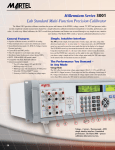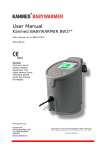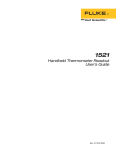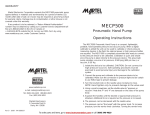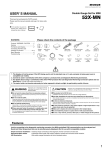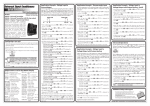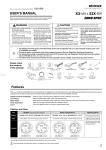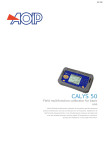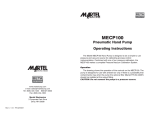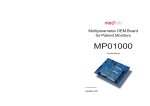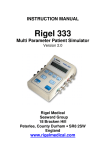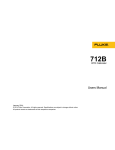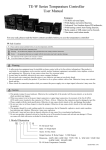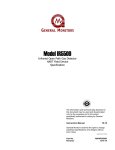Download Martel PTC-8001 Temperature Calibrator Manual PDF
Transcript
PTC8001 Temperature Calibrator Table of Contents 1. Introduction . . . . . . . . . . . . . . . . . . . .1 1.1 Customer Service . . . . . . . . . . . . . . . .1 1.2 Standard Equipment . . . . . . . . . . . . . .1 1.3 Safety Information . . . . . . . . . . . . . . . .2 2. Quick Start Instructions A. Key Functions . . . . . . . . . . . . . . . . . . . .5 B. Setpoints . . . . . . . . . . . . . . . . . . . . . . .6 3. Connection Diagrams & Instructions A. Sourcing Resistance . . . . . . . . . . . . . . .7 B. Sourcing a Thermocouple Signal . . . . .9 C. Measuring Temperature Using a Thermocouple . . . . . . . . . . . . . . . . . . .9 D. Measuring Resistance (RTDs) . . . . . . .10 E. Sourcing Resistance (RTDs) . . . . . . . .11 4. Maintenance A. Power Requirements . . . . . . . . . . . . .12 B. Field Replacement Fuse Update . . . . .12 C. Calibration . . . . . . . . . . . . . . . . . . . . .13 5. Specifications . . . . . . . . . . . . . . . . . . .14 6. Warranty . . . . . . . . . . . . . . . . . . . . . . .16 PTC8001 1. Introduction The PTC8001 is designed to be a versatile, easy to use temperature calibrator with a simple user interface. The following instructions will allow the user to begin simple calibration tasks by learning the basic operation of the keys and their functions. 1.1 Customer Service Corporate Office: www.martelcorp.com e-mail: [email protected] Tel: (603) 434-8179 800-821-0023 Fax: (603) 434-1653 Martel Electronics PO Box 770 1F Commons Drive Londonderry, NH 03053 1.2 Standard Equipment Check to see if your calibrator is complete. It should include: Calibrator, Instruction Manual, Test Leads, Rubber Boot, NIST Certificate 1 1.3 Safety information Symbols Used The following table lists the International Electrical Symbols. Some or all of these symbols may be used on the instrument or in this manual. Symbol Description AC (Alternating Current) AC-DC Battery CE Complies with European Union Directives DC Double Insulated Electric Shock Fuse PE Ground Hot Surface (Burn Hazard) Read the User’s Manual (Important Information) 2 Off On Canadian Standards Association The following definitions apply to the terms “Warning” and “Caution”. • “Warning” identifies conditions and actions that may pose hazards to the user. • “Caution” identifies conditions and actions that may damage the instrument being used. Use the calibrator only as specified in this manual, otherwise injury and damage to the calibrator may occur. Warning To avoid possible electric shock or personal injury: • Do not apply more than the rated voltage. See specifications for supported ranges. • Follow all equipment safety procedures. • Do not use the calibrator if it is damaged. Before you use the calibrator, inspect the case. Look for cracks or missing plastic. Pay particular attention to the insulation surrounding the connectors. • Select the proper function and range for your measurement. • Make sure the battery cover is closed and latched before you operate the calibrator. 3 • Remove test leads from the calibrator before you open the battery door. • Inspect the test leads for damaged insulation or exposed metal. Check test leads continuity. Replace damaged test leads before you use the calibrator. • Do not use the calibrator if it operates abnormally. Protection may be impaired. When in doubt, have the calibrator serviced. • Do not operate the calibrator around explosive gas, vapor, or dust. • Disconnect test leads before changing to another measure or source function. • When servicing the calibrator, use only specified replacement parts. • To avoid false readings, which could lead to possible electric shock or personal injury, replace the battery as soon as the battery indicator appears. Caution To avoid possible damage to calibrator or to equipment under test: • Disconnect the power and discharge all highvoltage capacitors before testing resistance or continuity. • Use the proper jacks, function, and range for your measurement or sourcing application. 4 2. Quick Start Instructions A. Key Functions Key Function Input/Output Toggles the function selected from measurement mode to source mode. Pressing the “TC” or “Thermocouple” key toggles through all available TC types as well as direct mV output. Pressing the RTD key toggles through all available RTD types as well as direct ohms output. Toggles between °F and °C These keys allow a user to enter an output value. Example: to output 20 mV select mV output and Press the “2” key then the “0” key followed by the “ENTER” key. These keys allow small changes to be made to an output value. Press either the up or the down key to set the value as desired. The clear entry key allows the user to clear a value before the enter key is pressed. This key has a blue text color and acts as a second function key to all keys that have an associated second function. TC RTD °F/°C 0-9 keys Arrow ↑↓ CE Shift 5 B. Setpoints 1. Storing Setpoints The setpoint mode allows up to 9 setpoints to be set in non-volitile memory for each range. The procedure is as follows: a. Set the output to the desired value. b. Press shift followed by the “SET” key c. Choose the desired setpoint storage location by pressing a key (1-9). d. Enter a new value and repeat steps 1 through 3 as needed, up to 9 setpoints for each range can be stored. 2. Recalling Setpoints a. To recall a setpoint press shift followed by the”SPT” key. b. You will be prompted to enter the number of the desired setpoint location set previously. c. Press the desired location number and the unit will go to that output. 3. Automated Stepping The PTC8001 can auto-step through some or all of the stored setpoints for a given range. The procedure is as follows: a. Press “Shift” followed by “Auto”. b. “Auto SPT ?” will appear. Enter the ending setpoint location. Example: if you have all 9 setpoints stored but only want to step through the first 3 then enter ”3” for this question. 6 c. The next screen prompts you to enter the dwell time from 5 to 500 seconds. Simply enter a number in that range. d. Auto-step will begin. e. To exit auto-step press the “CE” key or enter a value. 4. Manual Stepping The PTC8001 can be manually stepped through all or some of the stored setpoints. The procedure is as follows: a. Press “Shift” followed by “Man” b. Using the arrow keys, toggle up and down through the stored setpoints. c. To exit press “CE” or simply enter a new output value. 3. Connection Diagrams & Instructions A. Sourcing Resistance 1. Select the RTD mode. 2. Connect device under test as shown. 3. In the RTD mode, use the RTD key to choose the desired range. 4. The PTC8001 is able to handle up to a 3 mA excitation on the Resistance Simulation Range. Exceeding these limits will result in a warning on the display. See Section E. for RTD Transmitter calibration. 7 8 Figure 1. B. Sourcing a Thermocouple Signal TC wire must be used to achieve an accurate calibration. Figure 2. Note: For best accuracy allow a 10 minute warm-up period after the PTC8001 is turned on. C. Measuring Temperature Using a Thermocouple Figure 3. 9 D. Measuring Resistance (RTDs) When measuring resistance (ohms) there are 3 choices when using the PTC8001. The choices are 2-wire, 3-wire, and 4-wire measurements. While 4-wire offers the highest accuracy, most industrial RTDs are a balance 3-wire. Figure 4 shows how to hook up the PTC8001 for the 3 types of measurements. 1. Choose the desired RTD/ohms range by first pressing the “RTD” key to get into the RTD mode. Continue to press the “RTD” key to step through all of the RTD choices. 2. Make sure the PTC8001 is in the Input Mode (Note: that it will indicate 2, 3, or 4W in the upper left corner of the LCD). To set the desired wire configuration use the Up/Down arrow keys to toggle through the 2, 3, and 4 wire modes. Measuring a 2 Wire RTD or Using the Continuity Function Measuring a 3 Wire RTD 10 Measuring a 4 Wire RTD Figure 4. E. Sourcing Resistance Into a RTD Transmitter 1. As described previously in section A the PTC8001 can source resistance in a RTD Transmitter or measuring device. In many cases the unit under test will require a 3 or 4 wire connection to achieve best accuracy. Refer to Figure 5 for connection information. Figure 5. 11 4. Maintenance A. Power Requirements The PTC8001 operates on 4 AA alkaline batteries or optional rechargeable Ni-Cd batteries. To replace the alkaline batteries or to install rechargeable batteries remove the two (2) screws on the rear battery door and lift the battery cover. When using Ni-Cd batteries the AC adapter will simultaneously power the PTC8001 and charge the batteries. A full charge will take 10-12 hours. The AC adapter can be used to power the unit on the bench with or without Ni-Cd batteries installed. Never connect the AC adapter with alkaline batteries installed, be sure to remove the alkaline batteries before using the AC adapter. B. Field Replacement Fuse Update PTC8001 comes with a field replaceable minifuse. This fuse protects the 8001 from misconnections beyond the ratings specified for the 8001 inputs and outputs. If an overload condition occurs and a blown fuse is suspected perform the following fuse check/replacement procedure: 1. Remove the four screws on the rear of the PTC8001 that hold the enclosure together. NOTE: Two of the screws are under the battery compartment door. 2. With the case top open, locate the two socketed mini fuses mounted near the input/output connection jacks. 3. Remove one fuse at a time and check continuity using an ohmmeter. A good fuse will read 10 ohms or less. A blown fuse will have a very high reading and generally show as an open circuit. 12 4. If a blown fuse is found replace with the enclosed spare fuse. 5. To order more fuses contact Martel Electronics and order part number 3535039. C. Calibration The PTC8001 should hold its rated specifications for a minimum of one year. Given this, annual re-calibration is required for best performance. See the customer service section to contact us for re-calibration information. 13 5. Specifications T/C Ranges: RTD Ranges: Ohms Ranges: Accuracy: RTD IEX-range: RTD Frequency Response: Oper. Temp: Storage Temp: Power Supply: Size: J, K, T, E, R, S, N, B, L, U including – 10 to 70 mV range Pt 385 (100, 200, 500, 1000 ohms) Pt 392, JIS, Ni 120, CU10, YSI 400 0 to 400.00 and 400.0 to 3200.0 T/C Type J: ±.3°C ±10 µV (±0.4°C total error) RTD PT100: ±.1°C ±.075 Ω (±0.3°C total error) Ohms (400): ±0.1 Ω Ohms (3200): ±1.0 Ω 0.01 mA to 3 mA 10 mS – works with all pulsed XMTR’s -10°C to 50°C -40°C to 60°C 4 AA Alkaline Cells, 30 hours typical operating time 7.5" x 4" x 1.5" Range & Accuracy Range ohms Read (low) ohms Read (high) Range Ohms Source (low) Ohms Source (high) Min 0.00 400.0 1500.0 Min Max 400.00 1500.0 3200.0 Max Excitation Accuracy Current 5.00 400.00 0.1 to 0.5 mA 0.15 ohm 5.00 400.00 0.5 to 3 mA 0.1 ohm 400.0 1500.0 0.05 to 0.8 mA 0.5 ohm 1500.0 3200.0 0.05 to 0.4 mA 1.0 ohm Thermocouple Read and Source (All errors included) Range Min Max J Thermocouple -200.0 0.0 0.0 1200.0 K Thermocouple -200.0 0.0 0.0 1370.0 T Thermocouple -200.0 0.0 0.0 400.0 E Thermocouple -200.0 0.0 0.0 950.0 R Thermocouple -20 0.0 0 500 500 1750 S Thermocouple -20 0 0 500 500 1750 14 Accuracy 0.1 ohm 0.5 ohm 1.0 ohm Accuracy 0.6°C 0.4°C 0.8°C 0.5°C 0.8°C 0.5°C 0.5°C 0.4°C 2.4°C 1.7°C 1.3°C 2.4°C 1.7°C 1.4°C Thermocouple Read and Source (All errors included) Range Min Max B Thermocouple 600 800 800 1000 1000 1800 L Thermocouple -200 0.0 0.0 900.0 U Thermocouple -200 0.0 0.0 400.0 N Thermocouple -200 0.0 0.0 1300.0 mV Read/Source -10.00 75.00 RTD Read and Source Range Ni120 (672) Pt100 (385) Pt100(3926) Pt100(3916) Pt200(385) Pt500(385) Pt1000(385) Cu10 Cu50 Cu100 YSI400 Min -80.0 -200.0 -200.0 -200.0 -200.0 -200.0 500.0 -200.0 100.0 -100.0 -180.0 -180.0 15.00 Max 260.0 800.0 630.0 630.0 630.0 500.0 630.0 100.0 630.0 250.0 200.0 200.0 50.00 Accuracy 2.1°C 1.7°C 1.3°C 0.45°C 0.4°C 0.7°C 0.45°C 1.1°C 0.6°C 0.015% ± 2 Accuracy 0.2°C 0.33°C 0.3°C 0.3°C 0.8°C 0.3°C 0.4°C 0.2°C 0.3°C 2.2°C 0.5°C 0.3°C 0.05°C 15 6. Warranty Martel Electronics Corporation warrants all products against material defects and workmanship for a period of twelve (12) months after the date of shipment. Problems or defects that arise from misuse or abuse of the instrument are not covered. If any product is to be returned, a “Return Material Authorization” number must be obtained from our Customer Service Department. This number must be indicated on the return package as notice to our Receiving Department to accept the shipment. Any package not so marked will not be accepted and will be returned to the shipper. Martel will not be responsible for damage as a result of poor return packaging. Out of warranty repairs and recalibration will be subject to specific charges. Under no circumstances will Martel Electronics be liable for any device or circumstance beyond the value of the product. 16 www.martelcorp.com e-mail: [email protected] Tel: (603) 434-8179 800-821-0023 Fax: (603) 434-1653 Martel Electronics PO Box 770 1F Commons Drive Londonderry, NH 03053 Rev E 0219042 7/06
























